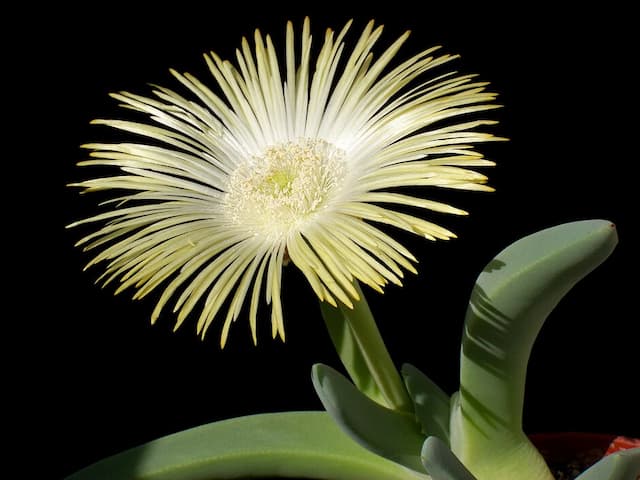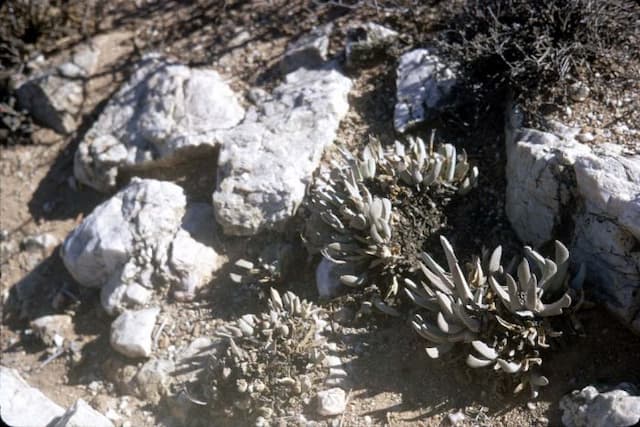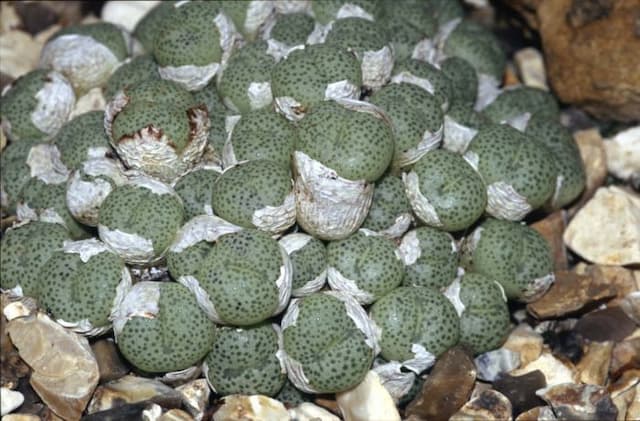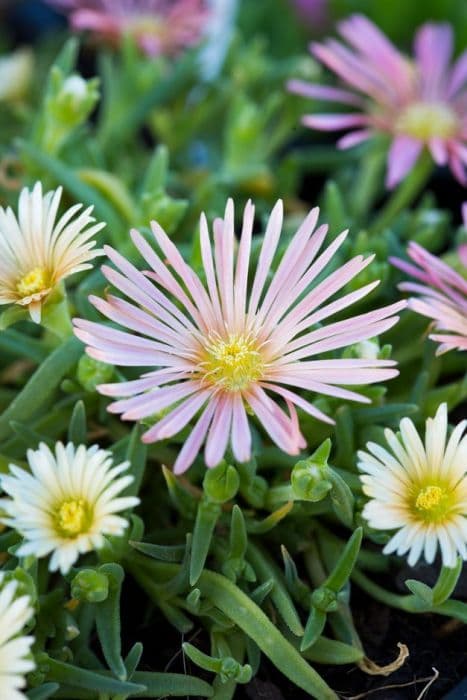Living stones Conophytum bilobum

ABOUT
Conophytum bilobum, commonly known as the "Dumpling Plant" due to its shape, possesses a distinctive and charming appearance that captivates succulent enthusiasts. The plant features two fleshy leaves that are fused together, which gives it a bilobed, or two-lobe, appearance. These lobes are nearly symmetrical, appearing like a pair of green to bluish-green, fleshy hemispheres that are commonly dotted with lighter or darker spots or patterns that add to their unique look. During certain times of the year, the Dumpling Plant blooms with small, yellow or occasionally pink flowers that emerge from the crevice between the two lobes. The flowers contrast delightfully with the succulent leaves, adding a pop of color to its appearance. The leaves themselves may take on a reddish tinge when exposed to sufficient sunlight, which further enhances its ornamental appeal. The surface of the Dumpling Plant leaves is smooth, and the plant has a very compact structure without any stems, as the leaves emerge directly from the rootstock. This creates a low, rounded cluster that resembles a collection of miniature, green dumplings nestled closely together.
About this plant
 Names
NamesSynonyms
Living Pebbles, Cone Plants, Dumplings.
Common names
Conophytum bilobum, Conophytum obcordellum, Conophytum obcordellum var. ceresianum, Conophytum obcordellum var. obcordellum.
 Toxicity
ToxicityTo humans
Conophytum bilobum, more commonly known as Button Plant, is not known to be toxic to humans. There are no widespread reports of poisoning or adverse effects from ingesting or handling the Button Plant. Therefore, it's generally considered safe around humans, but as with any plant, it is advisable to avoid ingestion and to use caution, especially around children or individuals with plant sensitivities.
To pets
The Button Plant, or Conophytum bilobum, is also not known to be toxic to pets. There is no evidence to suggest that ingestion of this plant by pets leads to poisoning or has harmful effects. However, as with any non-food plant, ingestion may cause mild gastrointestinal upset simply because it is not part of a pet’s normal diet. It is always prudent to monitor pets around houseplants and discourage them from chewing on plants.
 Characteristics
CharacteristicsLife cycle
Perennials
Foliage type
Evergreen
Color of leaves
Green
Flower color
Yellow
Height
0.5 inches (1.3 cm)
Spread
1 inch (2.5 cm)
Plant type
Succulent
Hardiness zones
10
Native area
South Africa
Benefits
 General Benefits
General Benefits- Low Maintenance: Conophytum bilobum, commonly known as Living Pebbles, requires minimal watering and care, making it ideal for busy plant lovers or those new to gardening.
- Drought-Tolerant: Living Pebbles have adapted to survive in arid environments, making them exceptionally drought-tolerant and an excellent choice for water-wise gardens.
- Aesthetic Appeal: This plant offers an unusual and sculptural aesthetic with its pebble-like appearance, providing a unique visual interest in rockeries or succulent displays.
- Compact Size: Due to its small size, Living Pebbles is well-suited for cultivation in containers and can be easily accommodated on windowsills or desks.
- Propagation Ease: It easily propagates from offsets, allowing gardeners to expand their collection or share with friends and family.
 Medical Properties
Medical PropertiesThis plant is not used for medical purposes.
 Air-purifying Qualities
Air-purifying QualitiesThis plant is not specifically known for air purifying qualities.
 Other Uses
Other Uses- Conophytum bilobum, commonly known as "Button Plant," can be used in miniature gardens for their small, compact shape, ideal for creating intricate landscapes in small containers.
- The "Button Plant" can be used as a living mulch in arid gardens, covering the soil and helping to reduce evaporation with its succulent leaves.
- Due to their interesting texture and shape, Button Plants can be employed in sensory gardens to provide a unique tactile experience.
- Button Plants can be gifted as a symbol of endurance and resilience, representing the ability to thrive in challenging conditions.
- The Button Plant is suitable for use in educational settings, such as schools, to teach children about xerophytic adaptations in plants.
- They can be showcased in art installations and photography due to their geometric shapes and varied colors that change with the seasons.
- Button Plants are often used in rockeries, providing a contrast against larger rocks and complementing other succulents or xerophytes.
- They can serve as companion plants for solar panels, installed in the surrounding area to landscape and cool the environment without growing too tall.
- As part of psychological therapy, cultivating Button Plants may be used to help individuals develop patience and attentiveness through plant care.
- These plants can also be used as natural jewelry, with their dried flowers or leaves being incorporated into pendants or earrings (ensure they are sustainably harvested).
Interesting Facts
 Feng Shui
Feng ShuiThe Conophytum is not used in Feng Shui practice.
 Zodiac Sign Compitability
Zodiac Sign CompitabilityThe Conophytum is not used in astrology practice.
 Plant Symbolism
Plant Symbolism- Resilience and Adaptability: Conophytum bilobum, commonly known as the "Button Plant," thrives in harsh, arid environments, symbolizing the ability to adapt and persist through challenging conditions.
- Preciousness and Rarity: This plant is a rare succulent, which can signify uniqueness and the value of scarce resources or attributes.
- Patience and Timing: The Button Plant has a slow growth rate, indicative of the virtue of patience and the importance of allowing things to develop in their own time.
- Conservation and Environmental Awareness: As a plant that requires minimal water, the Button Plant represents the importance of conserving resources and being environmentally conscious.
 Water
WaterButton plants, as Conophytum bilobum are commonly known, require minimal but careful watering. During the active growth period in the fall and winter, water them thoroughly once every two to three weeks, allowing the soil to dry out between waterings. The amount needed is roughly one ounce per plant for small pots, ensuring that water doesn't sit in the saucer. During their summer dormant period, refrain from watering entirely or water very sparingly, not exceeding one ounce per plant once a month to prevent shriveling.
 Light
LightButton plants thrive in bright, indirect sunlight. The ideal spot is one where they can receive a few hours of morning sun with protection from intense afternoon rays. A bright windowsill that receives filtered light through a sheer curtain or a position that gives dappled shade can suit their light needs efficiently and prevent sunburn.
 Temperature
TemperatureButton plants prefer temperate conditions, with ideal temperatures ranging between 50 and 77 degrees Fahrenheit. They can withstand a minimum temperature of 32 degrees Fahrenheit for short periods but should not be exposed to frost. The maximum temperature should not exceed 86 degrees Fahrenheit, as excessive heat can stress the plant.
 Pruning
PruningPruning is not usually necessary for Button plants, but any dead or damaged leaves can be carefully removed to maintain plant health and appearance. This is typically done after the summer dormancy, as the plant prepares for its growth season. Pruning is done as needed, rather than on a regular schedule, focusing only on old plant material that naturally detaches from the healthy growth.
 Cleaning
CleaningAs needed
 Soil
SoilLiving Stones (Conophytum bilobum) thrive in a well-draining soil mix composed of one part potting soil, one part coarse sand, and one part perlite or pumice. Aim for a soil pH between 5.5 and 7.5 for optimal growth.
 Repotting
RepottingLiving Stones should be repotted every few years or when they outgrow their container. The best time to repot is at the end of the dormant season, right before the growing season begins.
 Humidity & Misting
Humidity & MistingLiving Stones prefer a dry environment with low humidity levels, which mimic their native South African habitat; avoid high humidity to prevent rot.
 Suitable locations
Suitable locationsIndoor
Place Living Stones in bright light and ensure proper air circulation indoors.
Outdoor
Grow Living Stones in full to partial sun with good air flow.
Hardiness zone
9-11 USDA
 Life cycle
Life cycleConophytum bilobum, commonly known as the 'Dumpling Plant,' begins its life cycle as a seed shed from the fruit and germinating typically after rainfalls in its natural habitat, needing well-drained soil and light to moderate moisture. Germination ensues within a few weeks under suitable conditions, leading to the development of small, paired succulent leaves that form the plant's characteristic bilobed structure. Over several years, the plant reaches maturity and forms yellow, white, or pink flowers in the autumn which open in the afternoon and close at night. After pollination, often by insects, the flowers produce small fruit capsules containing numerous tiny seeds. The plant typically enters a dormant period in the hot summer months, with the leaves retracting and becoming less visible. Over many years, Conophytum bilobum can form clumps by division as each pair of leaves can gives rise to a new pair, allowing the plant to spread slowly.
 Propogation
PropogationPropogation time
Late summer to fall
Propogation: The most popular method of propagation for Conophytum bilobum, commonly known as the 'Living Stones', is through seed. The best time for sowing seeds is in the autumn, as cooler temperatures can assist with germination. To propagate Conophytum bilobum, seeds are sown shallowly in a well-draining soil mix. It's important to keep the soil moist but not waterlogged, and the seeds require a warm and bright environment to germinate, though not in direct sunlight. Once seedlings appear, which may take several weeks, they should be allowed to grow in the same pot for a season until they have strengthened enough to handle transplantation. Care must be taken to avoid disturbing the delicate roots during the transplanting process.









